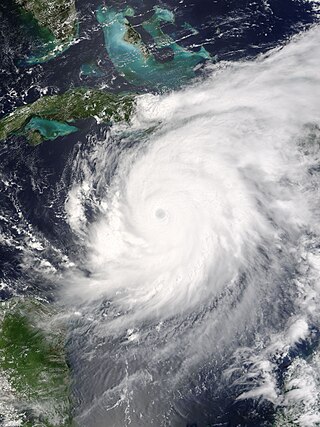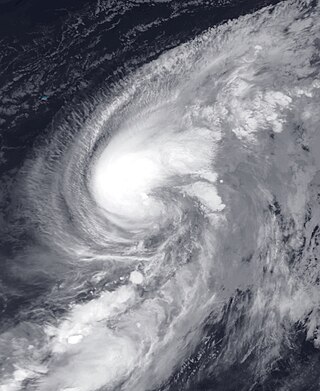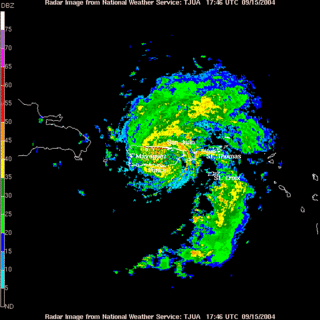| |||||
| Decades: | |||||
|---|---|---|---|---|---|
| See also: | |||||
Events in the year 2024 in Puerto Rico .
| |||||
| Decades: | |||||
|---|---|---|---|---|---|
| See also: | |||||
Events in the year 2024 in Puerto Rico .
Source: [6]

Hurricane Lenny was the strongest November Atlantic hurricane since the 1932 Cuba hurricane. It was the twelfth tropical storm, eighth hurricane, and record-breaking fifth Category 4 hurricane in the 1999 Atlantic hurricane season. Lenny formed on November 13 in the western Caribbean Sea at around 18:00 UTC and went on to form and maintain an unusual and unprecedented easterly track for its entire duration, which gave it the common nickname, "Wrong Way Lenny". It attained hurricane status south of Jamaica on November 15 and passed south of Hispaniola and Puerto Rico over the next few days. Lenny rapidly intensified over the northeastern Caribbean on November 17, attaining peak winds of 155 mph (249 km/h) about 21 mi (34 km) south of Saint Croix in the United States Virgin Islands. It gradually weakened while moving through the Leeward Islands, eventually dissipating on November 23 over the open Atlantic Ocean.

Vega Baja is a town and municipality located on the coast of north central Puerto Rico. It is north of Morovis, east of Manatí, and west of Vega Alta. Vega Baja is spread over 14 barrios. The population of the municipality was 54,414 at the 2020 census. It is part of the San Juan–Caguas–Guaynabo metropolitan statistical area.

The effects of Hurricane Georges in Puerto Rico included $2 billion in damages and five fatalities. Hurricane Georges was the first hurricane to cross the entire island since the San Ciprian Hurricane in 1932. Georges formed on September 15 as Tropical Depression Seven off the African coast. Georges strengthened into a Category 4-hurricane on September 19 as it made landfall in the Lesser Antilles. Georges made landfall on the island on September 21 as a Category 3-hurricane. Georges caused $3 billion in damage to the island.

Hurricane Kyle was a Category 1 hurricane that caused heavy rain and flooding in Puerto Rico in its formative stage and brought hurricane-force winds to Nova Scotia while extratropical. The eleventh tropical storm and sixth hurricane of the 2008 Atlantic hurricane season, Kyle formed from a strong tropical disturbance that tracked across the northeastern Caribbean Sea in the third week of September. As a low pressure area, it moved slowly across Puerto Rico and Hispaniola, dumping torrential rains across those islands.

From September 8 to 14, 2004, Hurricane Ivan moved through the Caribbean Sea, affecting all of the Greater Antilles. Reaching peak winds of 165 mph (266 km/h), Ivan attained Category 5 strength on the Saffir-Simpson Hurricane Scale, the strongest possible category, on three times in the Caribbean. It first lashed the southern coasts of Puerto Rico and Hispaniola with high waves, killing five people in the Dominican Republic and Haiti; in the latter country, two others drowned due to storm flooding. The effects in Jamaica were among the worst from a tropical cyclone in the island's recorded history. The storm caused severe damage which left 18,000 people homeless. An estimated 17 people on the island were killed by Ivan.

The 1909 Greater Antilles hurricane was a rare, late-season tropical cyclone that caused extensive damage and loss of life in Jamaica and Haiti, and the wettest Atlantic hurricane on record. Forming out of a large disturbance in early November, the hurricane began as a minimal tropical storm over the southwestern Caribbean on November 8. Slowly tracking northeastward, the system gradually intensified. Late on November 11, the storm brushed the eastern tip of Jamaica before attaining hurricane status. The following afternoon, the storm made landfall in northwest Haiti with winds of 85 mph (135 km/h). After moving over the Atlantic Ocean, the hurricane further intensified and attained its peak winds of 105 mph (170 km/h) on November 13. The system rapidly transitioned into an extratropical cyclone the following day before being absorbed by a frontal system northeast of the Lesser Antilles.

Hurricane Edith brought flooding and wind damage to portions of the Greater and Lesser Antilles. The sixth tropical storm and fifth hurricane of the 1963 season, Edith developed east of the Windward Islands on September 23 from an Intertropical Convergence Zone (ITCZ) disturbance. Initially a tropical depression, it strengthened into Tropical Storm Edith the next day. Shortly thereafter, Edith reached hurricane status. Edith fluctuated between Category 1 and 2 status as it moved west-northwest. Upon reaching Category 2 intensity on September 25, the storm peaked with winds of 100 mph (155 km/h). After striking Saint Lucia on September 25, the storm traversed the eastern Caribbean Sea. Curving north-northwest on September 26, Edith made landfall near La Romana, Dominican Republic, early on the following day as a minimal hurricane. Interaction with land and an upper-level trough caused Edith to weaken to a tropical storm on September 28 and to a tropical depression by the next day. The storm dissipated just east of the Bahamas on September 29.

Hurricane Otto produced days of torrential rain over much of the northeastern Caribbean in October 2010. Otto originated as a subtropical cyclone lingering north of Puerto Rico on October 6, and transitioned into a tropical storm the next day, the fifteenth of the 2010 hurricane season. Accelerating toward the northeast, Otto strengthened into a Category 1 hurricane on the Saffir–Simpson scale on October 8, attaining peak winds of 85 mph (140 km/h). The storm began weakening due to incompatible surroundings and became extratropical west of the Azores on October 10. Otto was the first Atlantic tropical cyclone to transition from a subtropical storm since Tropical Storm Laura in 2008.

The effects of Hurricane Jeanne in Puerto Rico included the most damage from a tropical cyclone since Hurricane Georges in 1998. The tenth tropical storm of the 2004 Atlantic hurricane season, struck the U.S. territory of Puerto Rico on September 15 with 70 mph (110 km/h) winds. While crossing the island, the storm dropped heavy rainfall, peaking at 19.2 in (490 mm) at Aibonito, with a total of 23.75 in (603 mm) on the offshore island of Vieques. The rainfall caused widespread flooding, resulting in landslides and heavy crop damage. Winds reached 72 mph (116 km/h) at Cayey, and its combination with the rainfall left most of the island without power or water.

The 1970 Caribbean–Azores hurricane was an unnamed Atlantic hurricane that became the wettest known tropical cyclone on record to affect the United States territory of Puerto Rico. The long-lived system formed on September 24 just off the west coast of Africa, and for several days maintained a general westward track. It passed through the Lesser Antilles on October 1, and later stalled in the eastern Caribbean Sea. On October 8, the depression crossed over the Dominican Republic, and subsequently it accelerated to the northeast. It was declassified as a tropical cyclone on October 12, although its remnants persisted for another week before dissipating in the westerlies near the Azores.

Tropical Storm Emily was a weak Atlantic tropical cyclone that brought torrential rains to much of the northern Caribbean in 2011. The fifth named storm of the annual hurricane season, Emily developed from a strong but poorly organized tropical wave that traversed the open Atlantic over the last week July. On August 1, it approached the Lesser Antilles and became more consolidated, producing inclement weather over many of the northern islands. Two days later, the disturbance’s wind flow became more cyclonic with a defined center of circulation, which marked the formation of Tropical Storm Emily. The storm remained fairly irregular in structure, though generating strong thunderstorms and gusty winds along its path over the Caribbean Sea. On August 4, Emily was declassified as a tropical cyclone after the mountainous areas of Hispaniola further disrupted its diffuse circulation. Upon exiting the northeastern Caribbean on August 6, its remnants briefly regenerated into a tropical storm before dissipating completely the next day.

The 1985 Puerto Rico floods produced the deadliest single landslide on record in North America, that killed at least 130 people in the Mameyes neighborhood of barrio Portugués Urbano in Ponce. The floods were the result of a westward-moving tropical wave that emerged off the coast of Africa on September 29. The system moved into the Caribbean Sea on October 5 and produced torrential rainfall across Puerto Rico, peaking at 31.67 in (804 mm) in Toro Negro State Forest. Two stations broke their 24-hour rainfall records set in 1899. The rains caused severe flooding in the southern half of Puerto Rico, which isolated towns, washed out roads, and caused rivers to exceed their banks. In addition to the deadly landslide in Mameyes, the floods washed out a bridge in Santa Isabel that killed several people. The storm system caused about $125 million in damage and 180 deaths, which prompted a presidential disaster declaration. The tropical wave later spawned Tropical Storm Isabel.
Events in the year 2020 in Puerto Rico.
The following lists events that happened during 2020 in The Caribbean.

Hurricane Dorian caused relatively minor damage across the eastern Caribbean in late August 2019. Originating from a westward moving tropical wave, Dorian organized into a tropical cyclone on August 24 and reached the Lesser Antilles on August 26 as a tropical storm. Turning northwest, the system unexpectedly intensified to a hurricane as it struck the Virgin Islands on August 27. Antecedent to the storm's arrival, local governments across the archipelago issued tropical cyclone warnings and watches, readied public shelters, closed airports, and placed emergency crews on standby. Many of the threatened islands were still reeling from the devastation wrought by Hurricane Irma and Hurricane Maria in September 2017 and fears arose over embattled power grids. In the areas first affected, impacts were limited to gusty winds and modest rainfall. Effects were greater in the Virgin Islands where wind gusts reached 111 mph (179 km/h); however, damage was light. Multiple landslides occurred across the islands and Puerto Rico with only a handful of structures suffering damage. One person died in Puerto Rico while preparing for the storm.

Hispaniola is an island in the Caribbean, with the second largest size throughout all of the Caribbean. Throughout the centuries, since reliable records began, hundreds of hurricanes and tropical cyclones have affected Haiti and the Dominican Republic, the two countries that share the island. The most recent tropical cyclone to affect Hispaniola was Hurricane Franklin in August 2023.
Events in the year 2022 in Haiti.
Events in the year 2024 in Haiti.